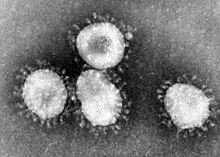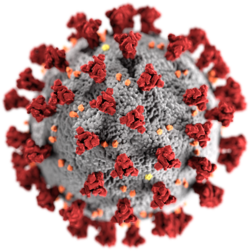Infektiøs bronkitisvirus hos fugle
| Infektiøs bronkitisvirus hos fugle (IBV) | |
|---|---|
 Enkelte viruspartikler (virioner) under elektronmikroskop | |
| Videnskabelig klassifikation | |
| Domæne | Riboviria |
| Rige | Orthornavirae |
| Række | Pisuviricota |
| Klasse | Pisoniviricetes |
| Orden | Nidovirales |
| Familie | Coronaviridae |
| Slægt | Gammacoronavirus |
| Underslægt | Igacovirus |
| Art | Avian coronavirus |
| Synonymer | |
(Engelske betegnelser overført) | |
| Hjælp til læsning af taksobokse | |
Infektiøs bronkitisvirus hos fugle (IBV, 'Aviær infektiøs bronkitisvirus'; en: 'Avian coronavirus', af la.: avis, 'fugl'[note 1]) er en coronavirus, der inficerer fugle og forårsager sygdommen infektiøs bronkitis (IB), der påvirker luftveje, tarm, nyre og reproduktionssystemet hos kyllinger.[3][4]
IBV påvirker ydeevnen for både kødproducerende og ægproducerende kyllinger og er ansvarlig for et betydeligt økonomisk tab inden for fjerkræbranchen.[5]
Noter og referencer
- Noter
- ^ Om mulige betegnelser:
- "Infektiøs bronchitisvirus (IBV) hos fugle" bruges på denne side hos Dansk Veterinær Konsortium: "Coronavirus i danske produktionsdyr, kæledyr og vilde dyr" fra Dkvet.dk, 2. marts 2020. "... Coronavirus er opdelt i fire forskellige slægter: Alphacoronavirus (f.eks. PEDV), betacoronavirus (f.eks. SARS og MERS-virus, samt Equin coronavirus (ECoV)), gammacoronavirus (f.eks. Infektiøs bronchitisvirus (IBV) hos fugle) og deltacoronavirus (f.eks. Porcin deltacoronavirus (PDCV)). ..."
- "Aviær infektiøs bronkitisvirus" eller lignende. På en side der vedrører 'aviær influenza' "Udbrudsmanual for aviær influenza" Arkiveret 5. juli 2020 hos Wayback Machine hos Foedevarestyrelsen.dk fra 10. juli 2015 er brugt udtrykket: 'Aviær pneumovirus, infektiøs bronkitisvirus'. (Pneumoviridae (engelsk))
- Artsnavnet: 'Avian coronavirus' som det fremgår af wikispecies:Avian coronavirus
- Referencer
- ^ ICTV 7th Report van Regenmortel, M.H.V., Fauquet, C.M., Bishop, D.H.L., Carstens, E.B., Estes, M.K., Lemon, S.M., Maniloff, J., Mayo, M.A., McGeoch, D.J., Pringle, C.R. and Wickner, R.B. (2000). Virus taxonomy. Seventh report of the International Committee on Taxonomy of Viruses. Academic Press, San Diego.1162 pp. https://talk.ictvonline.org/ictv/proposals/ICTV%207th%20Report.pdf Arkiveret 24. februar 2021 hos Wayback Machine
- ^ a b c d e f de Groot, Raoul J.; et al. (2008). "Revision of the family Coronaviridae" (PDF) (engelsk). s. 24. Arkiveret fra originalen (PDF) 7. februar 2019. Hentet 9. marts 2020.
Avian coronavirus (new) (comprised existing species infectious bronchitis virus, turkey coronavirus, pheasant coronavirus, duck coronavirus, goose coronavirus, pigeon coronavirus)
- ^ Casais, R.; Thiel, V.; Siddell, S.G.; Cavanagh, D.; Britton, P. (2001). "Reverse genetics system for the avian coronavirus infectious bronchitis virus". Journal of Virology. 75 (24): 12359-12369. doi:10.1128/JVI.75.24.12359-12369.2001. PMC 116132. PMID 11711626.
- ^ Cavanagh, D. (2001). "A nomenclature for avian coronavirus isolates and the question of species status". Avian Pathology. 30 (2): 109-115. doi:10.1080/03079450120044506. PMID 19184884.
- ^ Cavanagh, D (2007). "Coronavirus avian infectious bronchitis virus". Veterinary Research. 38 (2): 281-97. doi:10.1051/vetres:2006055. PMID 17296157.

Se også
- Fugleinfluenza – Virusklassifikation – Veterinærmedicin – Definition af termer (virus)
Eksterne henvisninger
 Wikimedia Commons har flere filer relaterede til Avian influenza, fugleinfluenza
Wikimedia Commons har flere filer relaterede til Avian influenza, fugleinfluenza- Martins, Nelson (16. januar 2020). "International Committee on Taxonomy of Viruses". International Committee on Taxonomy of Virus. Arkiveret fra originalen den 16. januar 2020. Hentet 16. januar 2020.
{{cite web}}: CS1-vedligeholdelse: BOT: original-url status ukendt (link) - Gomaa, M.H.; Barta, J.R.; Ojkic, D.; Yoo, D. (2008). "Complete genomic sequence of turkey coronavirus". Virus Research. 135 (2): 237-246. doi:10.1016/j.virusres.2008.03.020. PMID 18468711.
- 'Taxon identifiers'. Engelsk hjælpeside til 'taksonindentifikatorer'
| Spire Denne artikel om biologi er en spire som bør udbygges. Du er velkommen til at hjælpe Wikipedia ved at udvide den. |
Medier brugt på denne side
Forfatter/Opretter: Emmanuel Boutet, Licens: CC BY-SA 2.5
A black bee (Apis mellifera mellifera.
This illustration, created at the Centers for Disease Control and Prevention (CDC), reveals ultrastructural morphology exhibited by coronaviruses. Note the spikes that adorn the outer surface of the virus, which impart the look of a corona surrounding the virion, when viewed electron microscopically. A novel coronavirus, named Severe Acute Respiratory Syndrome coronavirus 2 (SARS-CoV-2), was identified as the cause of an outbreak of respiratory illness first detected in Wuhan, China in 2019. The illness caused by this virus has been named coronavirus disease 2019 (COVID-19).
Coronaviruses are a group of viruses that have a halo, or crown-like (corona) appearance when viewed under an electron microscope.
- The coronavirus is now recognized as the etiologic agent of the 2003 SARS outbreak. Additional specimens are being tested to learn more about this coronavirus, and its etiologic link with Severe Acute Respiratory Syndrome. It was previously stated on the CDC website for a coloured version of the image that this depicts the (Avian) Infectious bronchitis virus (IBV), but now states that it depicts Human coronavirus 229E.
Forfatter/Opretter: art designer at PLoS, modified by Wikipedia users Nina, Beao, and JakobVoss, Licens: CC0
Open Access logo, converted into svg, designed by PLoS. This version with transparent background.




